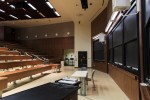Students can guide their peers through classes in a growing program called Learning Assistants at UCLA.
Learning assistants are students who help other students learn alongside regular teaching assistants and professors. This quarter, 11 professors had learning assistants in their classes, an increase from five in fall quarter and three last spring, when the program first started.
LAs, who teach mostly in the chemistry, physics and life sciences departments, work with students in small groups during discussion sections and answer students’ questions in class and in their own office hours. Program directors said LAs have improved students’ grades.
Shanna Shaked, a physics and astronomy professor and senior associate director of the Center for Education Innovation and Learning in the Sciences said LAs are especially helpful because they understand students’ struggles in classes.
LAs are required to have performed well in the courses they assist in, Shaked said. When students are selected, they must take a course about instruction techniques. After serving as an LA and completing the course for credit, students can apply to the paid Super-LA position.
The LA program is not related to the undergraduate assistant program that some professors have incorporated individually in classes. Undergraduate assistants do not have to go through the same pedagogy course, and students can be both LAs and undergraduate assistants.
Shaked said she started the program in 2014 after one of her students, who became the first LA, did an honors thesis about improving student learning. She also read published research supporting the benefits of peer teaching.
“Everything that I’ve learned about teaching is that (students) learn best by talking with each other about the material,” said Shaked.
In 2016, Shaked began working with a life sciences lecturer to create a formalized program under CEILS for multiple UCLA courses. The LA system has since expanded to 13 different courses with an LA in their class.
The Office of Instructional Development, the University of California Office of the President and a small National Science Foundation grant fund the program. The Super-LA program and pedagogy course together cost about $50,000 this year, Shaked said.
Shaked wrote in a report that LAs disproportionately improve the performance of students from underrepresented and low-income backgrounds.
“Low-income and underrepresented students tend to be more negatively impacted by a competitive classroom atmosphere,” she said. “LAs foster collaboration and are more approachable.”
Several students who have worked as learning assistants said they think the program is helpful.
Brandon Chen, a fourth-year chemistry student LA, said he wishes that UCLA would recognize the program more and endorse it across all departments.
He added he thinks the number of TAs should not be reduced if the LA program expands.
“I do not think that undergraduates can substitute graduate students and the traditional TA-led discussions, but I do think that the LA program can supplement just about any class in any department,” Chen said.
He added a common misconception is that students need to have earned an A in the course they want to help teach.
“While I think having a strong grade in that particular class helps, I don’t think it’s at all necessary,” Chen said. “I believe it’s more important to express interest in the subject you want to teach and in pedagogy itself.”
Irena Roy, a second-year molecular, cell and developmental biology student, said the application process to become an LA is straightforward. She said the application consists of writing about past teaching experiences and reasons for interest in the program.
Some students said they think their LAs help add to the classroom experience.
Sarah Adams, a first-year biochemistry student, said fellow students in her cluster course ask the LA questions they might not feel comfortable asking other teaching staff, such as what they should study for an exam.
“I wish my (LA) had a bigger room (for his office hours) because so many people go to him (and) he is so helpful that it tends to get really crowded and loud,” she added. “If they want to continue and have a successful program, they should invest in it a little more.”
Bridget Linney, a first-year biophysics student, said the LA in her class knows what her classmates are going through and can be more straightforward than a TA.
“A TA wouldn’t say, ‘You can skip over that reading,’ but (the LA has) taken the class, he knows what is important to look for,” Linney added.
Nikhil Shah, a third-year biochemistry student, paid researcher and LA for a physics course, said he thinks the LA program helps make learning more personalized.
“Students feel more comfortable with LAs and when you’re working in a four-on-one or three-on-one environment,” Shah said. “With our weekly meetings to review material, I never felt unprepared to help.”
Shaked said she hopes to expand the program in the next five years with financial support from UCLA and the National Science Foundation.
